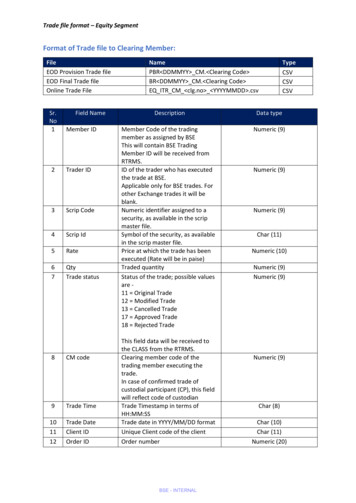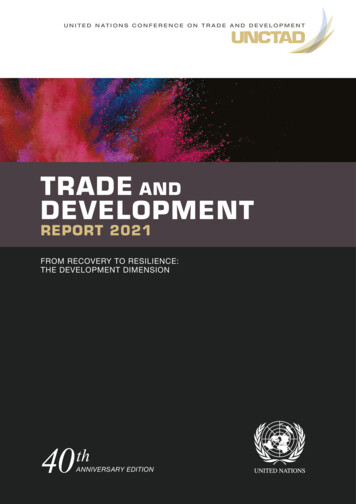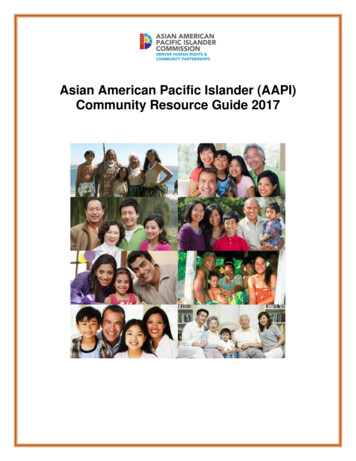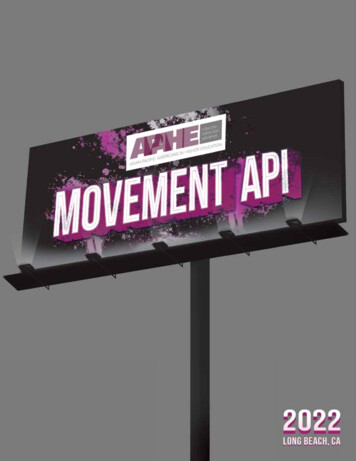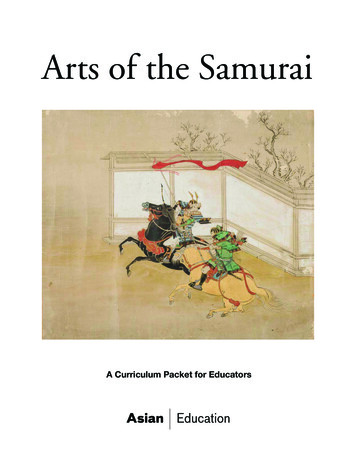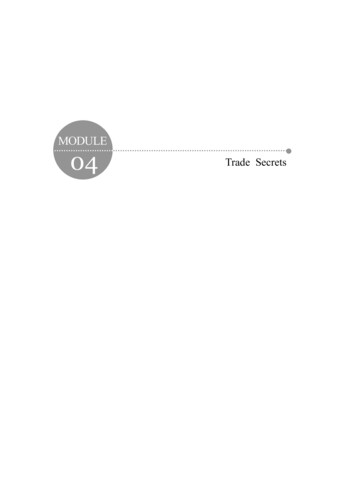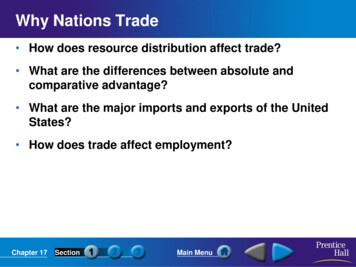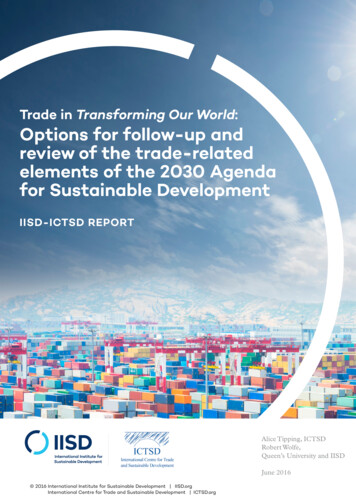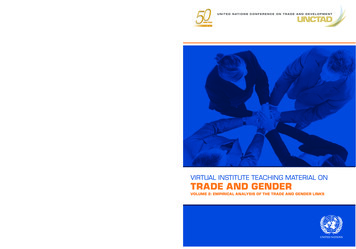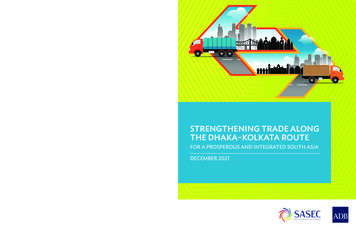
Transcription
Strengthening Trade along the Dhaka–Kolkata RouteFor a Prosperous and Integrated South AsiaThe economies of Bangladesh and India are driven by fast-growing bilateral trade. The efficient movementof goods between the two countries is essential to their economic growth. However, inefficient proceduresat land crossings, paired with infrastructure constraints on both sides of the border, inflate the time and costsof conducting trade. This study examines some of the key bottlenecks to trade on land between Dhaka andKolkata, and provides recommendations on how to address them. Reducing traffic congestion along the majorroutes, and improving facilities and clearance procedures at the border crossings can significantly improvetrade between Bangladesh and India, and contribute to more robust economic growth across the South AsiaSubregional Economic Cooperation zone as a whole.About the South Asia Subregional Economic Cooperation ProgramThe South Asia Subregional Economic Cooperation (SASEC) program brings together Bangladesh,Bhutan, India, Maldives, Myanmar, Nepal, and Sri Lanka in a project-based partnership that aimsto promote regional prosperity, improve economic opportunities, and build a better quality of life for thepeople of the subregion. SASEC countries share a common vision of boosting intraregional trade andcooperation in South Asia, while also developing connectivity and trade with Southeast Asia.About the Asian Development BankADB is committed to achieving a prosperous, inclusive, resilient, and sustainable Asia and the Pacific,while sustaining its efforts to eradicate extreme poverty. Established in 1966, it is owned by 68 members—49 from the region. Its main instruments for helping its developing member countries are policy dialogue,loans, equity investments, guarantees, grants, and technical assistance.Strengthening Trade AlongTHE Dhaka–Kolkata ROUTEFOR A PROSPEROUS AND INTEGRATED SOUTH ASIADECEMBER 2021Asian Development Bank6 ADB Avenue, Mandaluyong City1550 Metro Manila, Philippineswww.adb.org
Strengthening Trade AlongTHE Dhaka–Kolkata ROUTEFOR A PROSPEROUS AND INTEGRATED SOUTH ASIADECEMBER 2021
Creative Commons Attribution 3.0 IGO license (CC BY 3.0 IGO) 2021 Asian Development Bank6 ADB Avenue, Mandaluyong City, 1550 Metro Manila, PhilippinesTel 63 2 8632 4444; Fax 63 2 8636 2444www.adb.orgSome rights reserved. Published in 2021.ISBN 978-92-9269-211-7 (print); 978-92-9269-212-4 (electronic); 978-92-9269-213-1 (ebook)Publication Stock No. TCS210477-2DOI: http://dx.doi.org/10.22617/TCS210477-2The views expressed in this publication are those of the authors and do not necessarily reflect the views and policiesof the Asian Development Bank (ADB) or its Board of Governors or the governments they represent.ADB does not guarantee the accuracy of the data included in this publication and accepts no responsibility for anyconsequence of their use. The mention of specific companies or products of manufacturers does not imply that theyare endorsed or recommended by ADB in preference to others of a similar nature that are not mentioned.By making any designation of or reference to a particular territory or geographic area, or by using the term “country”in this document, ADB does not intend to make any judgments as to the legal or other status of any territory or area.This work is available under the Creative Commons Attribution 3.0 IGO license (CC BY 3.0 o/. By using the content of this publication, you agree to be boundby the terms of this license. For attribution, translations, adaptations, and permissions, please read the provisionsand terms of use at https://www.adb.org/terms-use#openaccess.This CC license does not apply to non-ADB copyright materials in this publication. If the material is attributedto another source, please contact the copyright owner or publisher of that source for permission to reproduce it.ADB cannot be held liable for any claims that arise as a result of your use of the material.Please contact pubsmarketing@adb.org if you have questions or comments with respect to content, or if you wishto obtain copyright permission for your intended use that does not fall within these terms, or for permission to usethe ADB logo.Corrigenda to ADB publications may be found at n this publication, “ ” refers to United States dollars.ADB recognizes “China” as the People’s Republic of China.Cover design by Francis Joseph M. Manio.Printed on recycled paper
ContentsTables, Figures, and Box vPreface viAcknowledgments viiAbbreviations viii1 Introduction 21Context—Trading on Land Between Bangladesh and India 2The Dhaka–Kolkata Routes 2Barriers to Efficient Trade 3SASEC Facilitates Regional Cooperation and Trade 4Domestic Progress on Trade Facilitation 6Bangladesh 7India 83 Gateways to Efficient Trade A Unique Approach for Deeper Understanding 994 The Petrapole–Benapole Gateway Commodity Profile Growth in Trade The Petrapole Integrated Check Post The Benapole Land Port 12131314185 The Ghojadanga–Bhomra Gateway Commodity Profile Growth in Trade The Ghojadanga Land Customs Station The Bhomra Land Port 2324242428iii
ivContents6 The Gede–Darshana Gateway Commodity Profile Growth in Trade The Gede Land Customs Station The Darshana Land Port Synergies Among the Three Gateways 323234353840Conclusion: A Synergistic Approach to Trade Facilitation 42Appendixes1 Route Infrastructure Profile: Petrapole–Benapole Gateway 2 Route Infrastructure Profile: Ghojadanga–Bhomra Gateway 4348
Tables, Figures, and BOXTables1Key Facilities Available at Petrapole Integrated Check Post 2Issues and Proposed Solutions for Petrapole Integrated Check Post 3Key Facilities Available at the Benapole Land Port 4Issues in Benapole Land Port and Proposed Solutions 5Key Facilities Available at the Ghojadanga Land Customs Station 6Issues and Proposed Solutions for Ghojadanga Land Customs Station 7Key Facilities Available at the Bhomra Land Port 8Issues and Proposed Solutions for Bhomra Land Port 9Key Cargo Rail Routes and Augmentation Projects 10Issues and Proposed Solutions for Gede Land Customs Station 11Issues and Proposed Solutions for Darshana Land Port 12Issues and Proposed Solutions Across the Three Gateway Figures1Framework of the Trade Routes Study 2Location of the Petrapole–Benapole Gateway 3Location of the Ghojadanga–Bhomra Gateway 4 Major Commodities (by volume) Exported by India via Gede–Darshana, 2018–20195Utilization of Major Rail Routes Across West Bengal BoxOn the Road with Tons Yarn 14151920252628293536394110122333345v
PREFACEThe efficient movement of goods between Bangladesh and India is essential to economicgrowth in both countries. Land crossings account for nearly 40% of all bilateral tradebetween the two countries, and play an important role in strengthening trade ties whilereducing costs. However, inefficient trade procedures at land crossings, paired withinfrastructure constraints on both sides of the border, currently inflate the time and costs ofconducting trade.Of particular importance to bilateral trade are the land routes connecting the commercialhubs of Dhaka in Bangladesh and Kolkata in India. Addressing traffic congestion along thesemajor routes, as well as improving facilities and clearance procedures at the respectiveborder crossings, can significantly improve trade between Bangladesh and India. While thetwo countries have made progress to streamline trade on land, further improvements toinfrastructure and trade facilitation practices remain essential along the Dhaka–Kolkata routes.The South Asia Subregional Economic Cooperation program delivers wholistic support toimprove trade and socioeconomic development in the region, and is helping Bangladeshand India strengthen trade ties in support of a more prosperous and integratedsubregion. The Asian Development Bank is providing support through hard investmentsin infrastructure and facilities, as well as through soft interventions to improve tradefacilitation practices. This study, finalized in July 2020, examines some of the keybottlenecks to trade on land between Dhaka and Kolkata and provides recommendationson how to address them.vi
AcknowledgmentsThis publication was prepared under the overall guidance of Aileen H. Pangilinan, teamleader, Regional Cooperation (SASEC Trade Facilitation), Regional Cooperation andOperations Coordination Division, South Asia Department, Asian Development Bank(ADB); based on the report from Anindya Mallick of Deloitte Touche Tohmatsu India LLPand Shaquib Quoreshi of Business Intelligence Ltd., with inputs from Satish Reddy, tradefacilitation expert/international consultant. Roble P. Velasco-Rosenheim, internationalconsultant, wrote the publication; with editing support from ADB consultants Cyrel SanGabriel and Maria Guia S. De Guzman, and Esnerjames P. Fernandez, associate regionalcooperation officer, ADB. The content of the publication is based on a consultants’ reportdeveloped by Deloitte Touche Tohmatsu India LLP represented by Anindya Mallick,Shashikant Somani, and Madhusree Dasgupta.We would like to thank Angela Escudero, research analyst, ADB and colleagues in ADB’soffices in Bangladesh and India for their valuable time and inputs while preparing thepublication. We would also like to thank Fernan de Dios, ADB consultant, and ADB’sDepartment of Communications for providing graphics and feedback to strengthenthe publication.vii
AbbreviationsADBAsian Development BankASYCUDA United Nations Conference on Trade and DevelopmentAutomated System for Customs DataviiiBCPborder crossing pointCAGRcompound annual growth rateFSSAIFood Safety and Standards Authority of IndiaICDinland container depotICPintegrated check postJNPTJawaharlal Nehru Port TrustLCSland customs stationMTmetric tonNABLNational Accreditation Board for Testing and Calibration LaboratoriesRMSrisk management systemSASECSouth Asia Subregional Economic CooperationSWIFTSingle Window Interface for Facilitating TradeUNESCAPUnited Nations Economic and Social Commission for Asia and the Pacific
INTRODUCTIONThis publication highlights opportunities to streamline trade between Bangladesh and India,and focuses on three essential land routes between Dhaka and Kolkata. The publicationwas commissioned by the Asian Development Bank (ADB), under the regional technicalassistance for Implementing Trade Facilitation Initiatives under the South Asia SubregionalEconomic Cooperation Program (TA 9578-REG). This publication is based on acomprehensive study prepared for the technical assistance, which was intended to supportdecision making by policymakers and development partners in South Asia. This publicationsummarizes the key findings of the original study, for a wider audience of traders, governmentrepresentatives, and trade facilitation experts across the region.1
Context—Trading onLand Between Bangladeshand IndiaBangladesh and India are the two largest trade partners in the South Asia SubregionalEconomic Cooperation (SASEC) zone.1 India exports cotton, cereals, cars, machinery, fuel,and raw materials; while Bangladesh produces fabric, garments, apparel, and vegetables forexport to India. Bilateral trade is a key economic driver for both nations, and growing fast.In 2018, Bangladesh shipped 916 million worth of goods to India, and India shipped nearly 8,928 million in exports bound for Bangladesh. Together, their trade portfolio achieved acompound annual growth rate (CAGR) of 11.1% during 2014–2018, reaching a combined 9,844 million in 2018. In practice, this translates to business growth, jobs, and the conversionof raw materials into consumer goods (like shoes and shirts) for onward sale and use aroundthe world. The efficient movement of people and goods between the two countries isessential for reducing the costs of trade, fostering economic synergies to support growth,and driving inclusive socioeconomic development across the SASEC subregion as a whole.Goods travel between Bangladesh and India by road, rail, air, maritime, and inland waterways,with 38.5% of all trade in 2018 crossing by land. The majority of goods traveling fromBangladesh to India move by land, with 70.4% of exports to India transported by road or rail.The movement of goods from India to Bangladesh follows more diverse paths, with landtransport accounting for 35.2% of exports. This is in part because Indian exporters havemore shipping options than Bangladeshi counterparts, and because India’s export volumesare much larger.2 Increasing the use of land routes for trade between the two countries cansignificantly reduce costs. However, inefficiencies associated with outdated infrastructureand suboptimal trade facilitation practices on land currently hamper bilateral trade by roadand rail.The Dhaka–Kolkata RoutesA significant portion of cargo moving on land passes by way of the Dhaka–Kolkata traderoutes. As such, a small handful of border crossing points (BCPs) between the twocommercial hubs account for virtually all trade on land between Bangladesh and India.In 2018, about 96% of Bangladeshi exports to India plied by land passed through one of122SASEC is a project-based partnership that aims to promote regional prosperity, improve economic opportunities,and build a better quality of life. To date, its member countries are Bangladesh, Bhutan, India, Maldives, Myanmar,Nepal, and Sri Lanka.Geographic factors are also an important consideration. For instance, exports from the south of India can move moreconveniently by maritime trade, and this causes traders to use such alternative routes.
Context—Trading on Land Between Bangladesh and Indiafour crossings.3 The same was true for 95% of all cargoes moving by road or rail fromIndia to Bangladesh.4Of premier importance to the Dhaka–Kolkata trade path are three gateways:Petrapole–Benapole, Ghojadanga–Bhomra, and Gede–Darshana. ThePetrapole–Benapole gateway, alone, accounted for an average of 80% of allbilateral exports on land in 2018. Ghojadanga–Bhomra provides a relativelyquicker alternative to exporting goods from Bangladesh to India; and theGede–Darshana rail gateway connects Kolkata in India to Dhaka in Bangladesh,and onward to Southeast Asia through the Trans-Asia Rail Network. Together, thethree gateways are essential for bilateral trade, the movement of goods acrossSASEC, and onward commerce with Southeast Asia and international markets.Despite their economic significance, however, trade routes between Dhaka andKolkata suffer inefficiencies that hamper the movement of goods—generating highcosts to traders and government agencies alike. Addressing core inefficiencies alongthe three routes can speed up the movement of goods, increase bilateral tradevolumes, and reduce costs.Barriers to Efficient TradeThere are three key bottlenecks to quicker, lower-cost trade along the land routesconnecting Dhaka and Kolkata: (i) physical transport assets, such as roads, rails, and bridges,are inadequate to support current and projected trade volumes; (ii) BCPs lack infrastructure,like parking facilities, cold storage, and warehouse space to process cargoes; and(iii) the current enabling frameworks, including trade facilitation practices and supportingtechnology, are not conducive to the efficient processing and clearance of goods.Transport. Roads along the Dhaka–Kolkata traderoute are narrow and highly congested. In manyareas, roads are degrading because they are notbuilt to support heavy loads. Furthermore, the keyroutes pass through numerous urban centers andagglomerations, which slows traffic from the majorcommercial hubs to crossing points. In the absenceof bridges, trucks need to wait in long lines forcostly ferries over rivers; while limited freight trainservices from Dhaka to Kolkata restricts Bangladeshiexporters from using lower-cost transport services.Furthermore, there is a lack of adequate repair andhalting facilities for cargo vehicles along many of thekey routes, contributing to safety risks and additionalinefficiencies and traffic congestion.34Petrapole ICP and Benapole Land Port. This is thegate within Petrapole ICP and Benapole land port(photo from Deloitte Touche Tohmatsu India LLP).Portions of land exports by crossing were Petrapole–Benapole (81.7%), Burimari–Changrabandha (7.1%),Agartala–Akhaura (4.2%), and Sutarkandi–Sheola (3.5%).Land exports from India to Bangladesh passed through Petrapole–Benapole (78.3%), Hili (7.5%),Gede–Darshana (5.3%), and Ghojadanga–Bhomra (3.9%).3
4Strengthening Trade along the Dhaka–Kolkata RouteBorder crossing points. Land ports lack theequipment and facilities they need to processcargo in a timely manner. When freight arrives atgateways to secure clearance, trucks may haveto wait for hours and struggle to find adequateparking. Once trucks find parking, they may waitfor hours or even days before being granted entryto BCP facilities. Further, not all land ports havecold storage facilities, prohibiting the use of selectgateways when plying perishable cargo. The lackof health centers, restrooms, restaurants, andshops at parking areas (where drivers often waitfor more than a week) leads to concerns on thewell-being of commercial truck drivers.Facilitation processes and technology. Althoughcurrently undergoing modernization, many ofthe customs clearance procedures are carriedout manually, with limited coordination betweendomestic agencies to streamline processing.Furthermore, most traders are not aware of themethods they can avail to reduce wait times, such assubmitting declarations in advance and undergoingmaterial testing prior to arriving at customs.5Cargo to trucks. Cargo beingoffloaded to trucks at Darshana(photo from Deloitte ToucheTohmatsu India LLP).Inside Petrapole. A view of thePetrapole ICP (photo from DeloitteTouche Tohmatsu India LLP).The result is that moving cargo from Bangladesh toIndia (and vice versa), takes longer and costs morethan it needs to. Wait times lead to elevated costs and missed opportunities. Associatedcosts affect manufacturers, buyers, and transporters; while inefficient trade facilitationpractices create unnecessary burdens for government agencies. Understandingthe barriers that traders face on a daily basis helps illustrate just how much the twocountries stand to gain by addressing infrastructure and procedural bottlenecks.SASEC Facilitates Regional Cooperationand TradeThe Asian Development Bank (ADB) is working in close partnership with Bangladeshand India to address bottlenecks to trade. The SASEC program is a key vehicle forimproving connectivity and regional cooperation and integration, and has supportedtrade in South Asia for nearly 2 decades. SASEC brings together Bangladesh, Bhutan,India, Maldives, Myanmar, Nepal, and Sri Lanka in a project-based partnership topromote regional prosperity, improve economic opportunities, and build a better qualityof life for the people of the subregion. SASEC countries share a common vision ofboosting trade and cooperation in South Asia, while also developing connectivity andtrade with Southeast Asia, the People’s Republic of China, and global markets.5Material tests and certification are only required for specific items, and prior test results are accepted forbilaterally agreed items. The process is described in more detail in this report’s subsections on selected gateways.
Context—Trading on Land Between Bangladesh and IndiaBox: On the Road with Tons YarnShyamol works for a company in India that operates a large fleet of trucks. He drives one of those trucks and regularlymakes the trip from Kolkata to the Bangladeshi border. On this particular journey, his cargo will cross from the Indianborder at Petrapole, onward to Benapole in Bangladesh. There, another driver named Saif will take the cargo and ply iton to Dhaka.During the day, Shyamol’s truck is loaded with yarn from a manufacturer in West Bengal. The soft skeins of cotton willtravel to Bangladesh, where they will be woven into fabric and sewn into garments like the blue t-shirt Shyamol wears.It is fresh pressed and clean today, but Shyamol knows that by the end of his trip, he will need a change of clothes.So, when his truck is packed and ready to leave at 9:30 p.m., he climbs into the cab, toting a bag of toiletries and clothes.Now, with the moon up and traffic at a relative lull, he sets off for Petrapole.Shyamol first drives north for the city of Chakdah, hoping he doesn’t pop a tire or smell smoke from the hood of histruck. There are few, if any, repair facilities on this route, and no good places to stop. Fortunately, he arrives safely inChakdah after three and a half hours of driving—it’s past midnight, but he won’t rest yet.He turns east onto Highway 1 (SH1), which brings him to Bongaon—the municipality ahead of the Petrapole–Benapoleborder crossing. SH1 has only two lanes and is lined with parking facilities. It is almost always congested, and Shyamolhas to brake every few minutes as trucks pull out of parking lots, vying for space on the road. The last few kilometersof road before the Petrapole border crossing don’t have separate lanes for commercial and passenger vehicles, soeveryone is lumped together into one slow-moving stretch. Shyamol sighs, moving cautiously as motorcycles honk andweave between him and the cars ahead. It’s about three in the morning when he eventually arrives at his destination.The Petrapole integrated check post (ICP) itself does not have adequate parking facilities to house him (due to overcongestion), so Shyamol obtains a parking pass and serial number, and finds space in a private lot in Bongaon. He isexhausted from the long ride and has been developing a cough, but knows the parking area won’t have a medical facilityor any convenience stores, so he settles in for a long and uncomfortable wait. He knows he will be parked for a while,as there is always a backlog of vehicles waiting for export clearance at the Petrapole ICP. Trucks enter on a first come,first served basis, and there is close to no cell connectivity in the entire area. After sleeping a few hours, Shyamol wakesup, brushes his teeth, and investigates dining options. For the next few days he will eat at local stalls and sleep in histruck, not knowing when it will be his turn to enter the Petrapole ICP for clearance.On the eighth day, he is allowed into the ICP. The shipping bill was filed in advance, so ICP staff weigh his cargo, where required,and customs brokers (CBs) obtain the customs clearance for export of the yarns; and the CBs enter information about thetruck into the cross-border register to get a car pass so Shyamol can drive the shipment over to Benapole.Once Shyamol receives the car pass, he moves into the Benapole Land Port. Once in Bangladesh, he completes theprocedures that will allow him to hand his cargo off. He submits a copy of his car pass, registers with the Benapole LandPort Automation system, goes through another cargo weighment, and unloads the container of yarn into a warehouse.Meanwhile, the customs brokers file a bill of entry, and the customs officials conduct assessment and examination,request the duty payment, and generate the cargo release order and warehouse delivery request.Shyamol drives his empty truck back into India through the zero point and submits another copy of the car pass to theofficials, as proof of his return. Now, after 9 long days of transit and waiting, he can head back to Kolkata. On each trip,dwell times vary, and there is no telling when he will be home.In Bangladesh, Saif takes over the shipment of yarn. He drives into the Benapole Land Port, where the cargo is loadedonto his truck, and receives a gate pass that allows him to exit. Delayed, he starts his journey back to Dhaka.continued on next page5
6Strengthening Trade along the Dhaka–Kolkata RouteBox continuedSaif drives slowly to Jashore, moving through traffic on the two-lane highway out of Benapole. He arrives at the firstjunction after two hours and carries on toward Magura. Like Shyamol, Saif finds himself hoping the truck won’t breakdown, as there are no proper service stations on this stretch of road. He arrives in Magura after nearly two hours andcontinues on to the Daulatdia ferry terminal to cross the Padma River.Saif gets impatient as traffic thickens approaching the river. There is a long wait for the ferry, and limited parking. Heis at a standstill in traffic for nearly four hours waiting his turn for the 30-minute ferry. He wonders—as he often doeswhile waiting at the river’s edge—why there aren’t more ferries or a quicker route over the Padma. Surely, the river couldhold a few more boats, and there are certainly enough trucks to use it.Finally, Saif and the yarns make it across the river. He sets out toward Dhaka on N5. It’s the last leg of his trip. He knowsit should take just over two hours; but again, the highway has only two lanes, traffic is heavy, and it takes four hours toreach his destination. Finally, Saif unloads the cargo after 15.5 hours on the road, and heads home.Shyamol and Saif are real drivers. While this story is partially fictionalized, it is based on a common experience of truckdrivers transporting cargo along real routes between Kolkata and Dhaka and using the Petrapole–Benapole bordercrossing point. Embellishments aside, the routes, export processes, and timelines described in the story are based on theiraccounts—indicating the real barriers traders face when plying cargo between the two commercial hubs on a daily basis.Source: Author’s interpretation of an unpublished ADB study, Case Study for Transit along Kolkata to Dhaka Route viaPetrapole–Benapole.SASEC strengthens multimodal, cross-border transport networks to boostintraregional commerce and open up trade opportunities with East and SoutheastAsia. The program helps build modern and effective trade facilitation regimes tospeed up the time and reduce the costs for moving goods, vehicles, and people acrossborders. Support for better connectivity is helping unleash the tremendous potentialfor mutually beneficial trade between the seven SASEC countries, which remainsome of the least economically integrated in the world. ADB serves as the secretariatfor SASEC. It also supports regional cooperation alongside national initiatives tostrengthen commerce and trade with investments and technical assistance.Domestic Progress on Trade FacilitationTrade facilitation initiatives can be categorized into hard and soft interventions. Hardinterventions are those which address physical infrastructure, including transport andBCP assets. Soft interventions are those that use policy, regulation, and digital toolsto streamline the movement of goods across borders, while ensuring appropriate riskmanagement and compliance management measures are in place. Complementaritybetween hard and soft interventions is essential for reducing trade costs, increasingtrade, and preserving appropriate controls and border security.The governments of Bangladesh and India—in close partnership with the SASECprogram, ADB, and other development partners in the region—have taken greatstrides to promote bilateral trade with improved infrastructure and trade processes.
Context—Trading on Land Between Bangladesh and IndiaBoth governments are currently implementing pipelines of hard and soft interventionsto streamline trade. Improvements will reduce the costs of importing and exportinggoods and help scale up trade bilaterally, across SASEC, and internationally. However,further progress remains to be achieved.BangladeshBangladesh is ranked 168th out of 190 economies in the “Trading Across Borders”category of the World Bank’s Doing Business 2020 report.6 While it has initiatedreforms to upgrade infrastructure and trade facilitation processes, there is significantscope for further improvements. Analysis suggests that modern customs and borderclearance procedure can decrease the cost of trading between 14% and 17.5% in lowermiddle-income countries like Bangladesh.7 To date, the following key interventionsare completed or underway in Bangladesh:8Hard interventions(i)(ii)Construct and upgrade transnational highways and railways, and make commitmentsto continue improving physical connectivity under two United Nations Economicand Social Commission for Asia and the Pacific (UNESCAP) initiatives fordeveloping the Asian Highway Network and the Trans-Asian Railway Network.9Augment border crossings to improve facilities for storing and processing cargo.Soft interventions(iii)Implement ASYCUDA World (a computerized customs management system)across all of its major ports and customs stations to streamline cargo processing.10(iv) Draft a new Customs Act, which will replace the Customs Act 1969 tomodernize and digitize customs practices in Bangladesh.(v) Introduce automation on a pilot-basis to streamline workflows at Benapoleincluding the “Benapass” software and “Benapole Land Port Automation System.”(vi) Prepare to implement a Single Window and Customs Modernization Planwith support from the World Bank and buy-in from 38 agencies, whichwill allow traders to submit all import, export, and transit information in acentralized digital portal.678910World Bank. 2020. Doing Business 2020. Washington, DC. After the 2020 report, World Bank managementpaused the next Doing Business report.Business Times. 2018. Bangladesh National Single Window for Trade.More details on the works underway at specific border crossings are provided on page 14 and onward.UNESCAP. 2004. Intergovernmental Agreement on the Asian Highway Network; UNESCAP. 2017.Intergovernmental Agreement on the Trans-Asian Railway Network.“ASYCUDA is a computerized customs management system which covers most foreign trade procedures.The system handles manifests and customs declarations, accounting procedures, transit and suspenseprocedures. It generates trade data that can be used f
Conte—Xt trading on land Between BangladeSh and india Bangladesh and India are the two largest trade partners in the South Asia Subregional Economic Cooperation (SASEC) zone.1 India exports cotton, cereals, cars, machinery, fuel, and raw materials; while Bangladesh produces fabric, garments, apparel, and vegetables for export to India.
